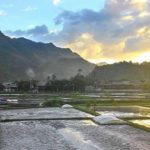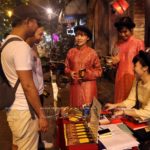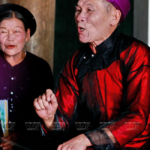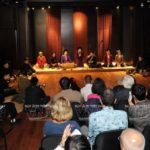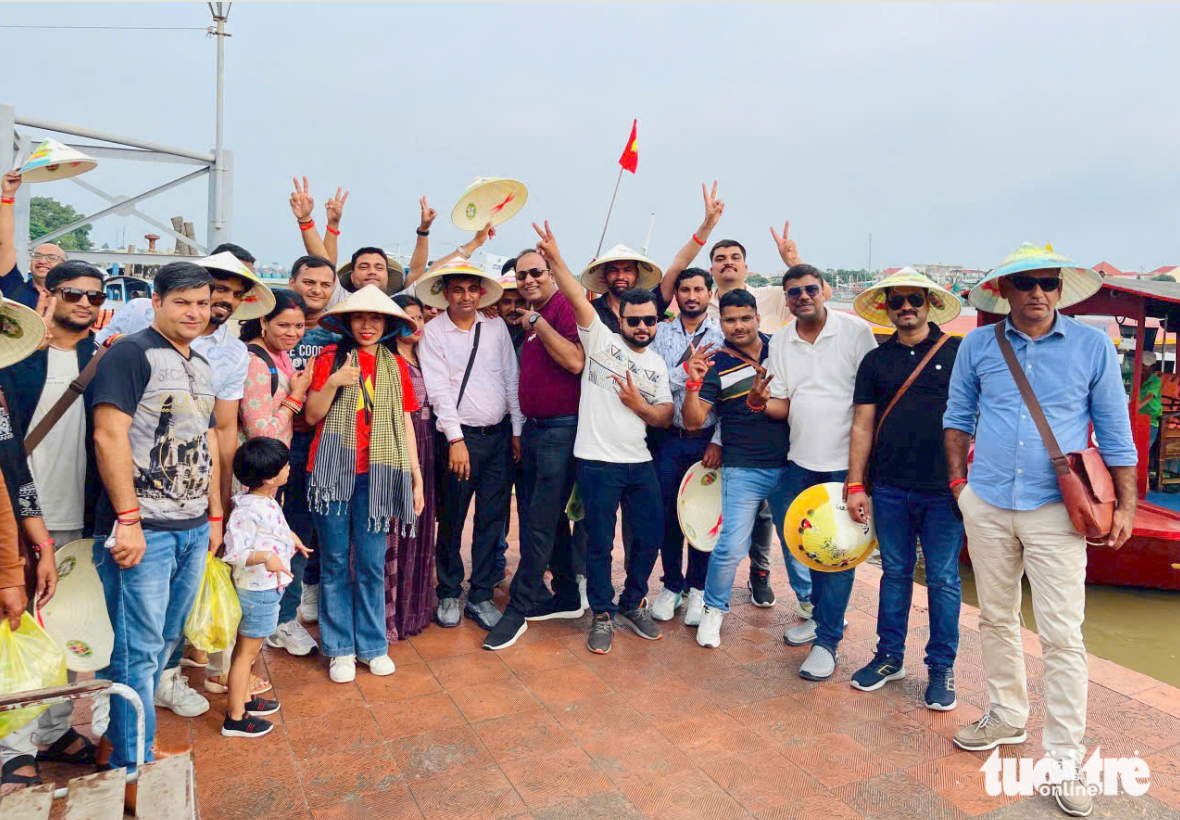Editor’s words
Thierry Vergon, director of the French Institute in Vietnam, attentively looks at the photographs on display at Photo Hanoi’23. He coordinated these activities out of curiosity to see how truthfully the images captured Vietnamese culture and the country’s transformation.
Initially, the first international biennial Photo Hanoi’23 has succeeded in enhancing public perception of Hanoi, shaping the photography market, and creating an ecosystem for photography that includes galleries, museums, artists and directors, collectors, critics, and the public, thus helping to boost the development of the capital’s cultural industry.
Hanoi has been implementing the National Strategy for the Development of Vietnam’s Cultural Industries to 2020 for six years (1997-2023), with a vision for 2030.
Hanoi is also the first locality to adopt a thematic resolution on the cultural industry, demonstrating the city government’s determination to pioneer the development of the cultural industry to realize the goal of preserving and promoting age-old cultural values and turning the cultural industry into a spearhead economic sector.
The destination is clear, but the journey remains arduous. For only when every citizen correctly understands and fully comprehends the concept of cultural industry can the potential of this treasure be unleashed.
Through five articles, The Hanoi Times seeks to explore the shape of Vietnam’s cultural industry and ways to establish Hanoi-Vietnam’s cultural sector as a global player.
Huge potential to develop cultural industry
Vietnamese conductor Dong Quang Vinh, born in 1984, still remembers the admiring glance from audiences after he finished playing the flute to perform the traditional music piece Xu so Mat troi moc (The land of the rising sun) in Japan when he was 12 years old.
| Suc Song Moi (The New Vitality) is Vietnam’s only bamboo ensemble. |
The Japanese audience’s admiration that day encouraged Vinh to pursue his passion for traditional music and made him feel more love and pride for the national cultural capital. He realized that the treasure of Vietnamese musical instruments is extremely rich and expressive, such as the gourd with a single string that can make many sounds, the K’ni that can imitate the human voice (the sound of a baby crying and a mother’s lullaby to put the child to sleep), and the Klong Put is played by clapping the hands without touching it.
Vinh told The Hanoi Times that his love of traditional music inspired him and his fellow musicians to form Suc Song Moi (The New Vitality) – Vietnam’s only bamboo ensemble performing its symphonically orchestrated repertoire purely with bamboo musical instruments.
“We have toured the world and have been warmly welcomed by audiences everywhere. There are some foreign audiences and Oversea Vietnamese who shed tears when listening to traditional music. They said that New Vitality’s songs were both familiar and strange. Some people asked to hear some pieces of music that make them cry again,” Vinh said.
| Conductor Dong Quang Vinh has performed with the Suc Song Moi ensemble in many countries. Photo courtesy of the artist |
The language of music transcends boundaries. We play classical music from Vietnam and the world using traditional folk instruments. It is an effective way to introduce the country’s culture,” he added.
Music lovers have recently witnessed the rise of the song See Tinh from Hoang Thuy Linh’s fourth album composed by DTAP. Although it has been released for more than a year, the song’s allure has not faded. It has spread to many Asian countries such as Thailand, China, Korea, and many celebrities, including Psy, Choi Yena, members of Super Junior, Exo Astro, Treasure, have danced to the song’s lovely melody.
Vinh and Linh are young Vietnamese artists who have taken Vietnamese culture beyond its border and gained success. The number of Vietnamese products that approached international audiences remains modest, but these successes are seen as a good omen for Vietnamese music and young artists, showing that with more support they would catch up with world music trends and better advertise Vietnam through cultural products.
Performing art is one of the 12 areas of Vietnam’s cultural industry structure. Others are cinema; publishing; fashion; fine arts, photography and exhibitions; television and radio; cultural tourism; advertisement; architecture; software and games; and traditional handicrafts.
Cultural industry as a cash cow
Historically, culture was once thought to be a field that benefited people’s spiritual life. Culture is now viewed as a field that contributes to economic growth, with a growing contribution to GDP. So what is the cultural industry? Have we realized this ” gemstone’s value and given it the care it deserves to shine?
| The song See Tinh from Hoang Thuy Linh has gone viral. Photo: Hoang Thuy Linh |
Nguyen Thi Quy Phuong, the former Deputy Director of the Institute for Journalism and Communication Studies, said every country has a culture, but not every country has a cultural industry.
“We are talking about a cultural industry whose concept is vague,” said Phuong
UNESCO defines cultural and creative industries as: “Sectors of organized activity whose principal purpose is the production or reproduction, promotion, distribution and/or commercialization of goods, services, and activities of a cultural, artistic or heritage-related nature.”
According to a report by UNESCO in February 2022, cultural and creative industries accounted for 3.1% of the global gross domestic product and 6.2% of global employment in 2020. That year, the Covid-19 pandemic posed unprecedented challenges to this market. Overall, it was estimated that the cultural and creative industries worldwide lost around US$750 billion in gross value added (GVA) and 10 million jobs in 2020 due to the pandemic.
These figures show that the cultural industry is currently the cash cow in many countries and the goal of developing the cultural industry into a spearhead economic sector will be a direction of Vietnam in line with the world trend.
Treasure of materials to boost cultural industry
Hanoi is the first city in Vietnam to issue a resolution on cultural industry development, demonstrating the determination of the people and authorities of Hanoi to promote cultural values as an economic spearhead.
Speaking about Hanoi’s potential and resources, Secretary of the Hanoi Party Committee Dinh Tien Dung said Hanoi is the capital of a thousand years of civilization, an important cultural center of the country; a place of convergence and civilized values of the nation,; a place of integration of the cultural quintessence of mankind.
In order to boost the development of Hanoi’s culture and people in a sustainable way, meeting the requirements of international integration, the Hanoi City Party Committee has just issued a Resolution on “Developing the cultural industry in the capital in 2021-2025, orientation to 2030, vision to 2045.”
| Singers of Hanoi perform ca tru. Photo: Lai Tan/The Hanoi Times |
Secretary of the Hanoi Party Committee Dinh Tien Dung stated that the Hanoi Party Committee determined that the development of the cultural industry should be integrated and based on the development of Vietnamese culture and people in general and the capital city in particular. This is a condition to maximize cultural and human resources, creating endogenous strength, an important driving force for the sustainable development of Hanoi.
“Developing the cultural industry is a priority in the socio-economic development strategy, with the goal of becoming a spearhead economic sector, effectively contributing to GDP growth, and generating more jobs and income. The cultural industry will motivate the development of other industries and fields, contributing to realizing the goal of rapid and sustainable development of the capital,” Dung said.
He said cultural industry development will be based on the principle of ensuring harmony between preservation and development, bringing into full play the potentials, strengths and traditional cultural values that make up the identity of the thousand-year-old capital.
The Hanoi Party Committee will focus on investing in the development of a number of potential and advantageous fields such as: Cultural tourism; performing arts; crafts; design; advertisement; fine arts, photography and exhibitions; film; fashion; cuisine; software and entertainment games; television and radio; publishing…
Specifically, by 2025, the capital’s cultural industry will become an important economic sector, creating a new driving force for economic, cultural and social development. By 2030, the capital’s cultural industry will basically become a spearhead economic sector, strongly promoting the development of other industries and fields. The revenue of cultural industries would increase year by year, with the aim of contributing about 8% of the city’s GRDP.
| Do Dinh Hong, Director of the Hanoi Department of Culture and Sports speaks at Photo Hanoi’23 biennale. Photo: The Hanoi Times |
By 2045, the capital’s cultural industry will be a spearhead economic sector, contributing about 10% of the city’s GRDP and to its comprehensive and sustainable economic, cultural and social development, making Hanoi the “Creative City” of Asia, a globally connected city, a large unique cultural and tourism center, with high international competitiveness.
In particular, Hanoi will focus on building, developing and positioning the UNESCO “Creative City” brand through a series of specific measures such as: building a creative design center in Hanoi and creative spaces; organizing the annual Hanoi Creative Design Festival and creating a network of young creative designers…
The Hanoi Government has invested a great deal in developing cultural tourism. In 2022, the capital’s tourism recovered strongly, with total revenue estimated at over VND 60 trillion (US$ 2.6 billion), an increase of 5.3 times compared to 2021.
Hanoi has also implemented the cooperation plan with foreign regions and capitals such as Athens (Greece), Ile-de-France (France), Singapore, Korea, Australia…, bringing the total to over 100 regions and territories that have cooperative ties with Hanoi.
Human resources: A key to developing the capital’s cultural industry
In order to realize the ambitious plans, the Hanoi Government is focusing on building and developing human resources, promoting the development of the cultural industry, and gradually turning culture into a spearhead economic sector.
The city has defined that human resources are the main components of the cultural industry, which directly determines the branding process, quality, and strength of the capital’s cultural industry. Human resources, especially high quality, are decisive factors for developing the capital’s cultural industry.
Regulators and cultural researchers have pointed out that human resources are an important resource, maximizing the power of human resources will contribute to the successful construction of the cultural industry.
| Audiences enjoy performance at Vietnam Drama Theater. Photo: The Hanoi Times |
Traditional performing arts such as cheo (operetta), cai luong (reformed theater), tuong (classic drama) are greatly influenced by current social development, which also affects the contingent of artists. People’s Artist Trung Hieu, Director of the Hanoi Drama Theater said that, at any stage of the cultural industry, the human factor always plays the preponderant role. Without adequate investment in human resources, the infrastructure system, though modern, cannot produce works of high artistic quality.
Hieu wishes young artists to be facilitated to learn from and absorb the cultural quintessence in countries with modern cultural industries, to be part of the East-West cultural integration, to develop the cultural industry, and to bring the country’s art to the world.
Since becoming a member of UNESCO’s Creative Cities Network, Hanoi has always stimulated the creativity of young people. This is a dynamic and enthusiastic force full of new and unique ideas.
In fact, young people are both beneficiaries of cultural values and pioneers in advancing the cultural industry, contributing to the creation of innovative products and new ways of approaching markets.
Shaping an innovative education ecosystem
According to cultural experts, unleashing people’s potential and career orientation is a mission of education.
Vietnam has devised a strategy for industrialization based on promotion-education-cultural positioning. Man is the subject and the driving force of all social activities, including work and creativity. Therefore, to develop a sustainable cultural industry, it’s necessary to start with educated, career-oriented children, and connected to society to be ready for the future.
| An art piece of Hanoi Drama Theater. Photo courtesy of the theater |
Professor Chu Cam Tho from the Vietnam Institute of Educational Sciences affirmed that an innovative education ecosystem is a solution to integrate the goals of education-career-cultural industry development.
This requires the proactive responsibility of professional organizations, businesses, researchers, experts, artists… in the field of cultural industry to coordinate with schools and the education sector to build an appropriate creative education ecosystem.
Meritorious Artist Duong Minh Anh, Rector of Hanoi College of Art, shared that the capital city has six professional art troupes and only one vocational art training institution.
These units are the official creative space to nurture, cultivate, discover and develop talents and open up opportunities for young artists.
At present, Hanoi College of Arts also aims to become a pioneer in creative education to train creative citizens of the capital.
Rector Anh said that it is necessary to have appropriate policies in training, nurturing, and discovering talents because human resources are the main factor in the capital’s cultural industry development.
Festival of northwest tourism villages to run in Hoa Binh
A festival gathering 14 typical community-based tourism villages across the northwest region will take place in Hoa Binh province from October 6 to 8.
Trong Quan Singing in Bui Xa
Trong quan singing, a type of popular art which alternates singing with drum accompaniments, has been performed for over 700 years in Bui Xa Village, Ninh Xa Commune, Thuan Thanh District of northern Bac Ninh Province. Local villagers are well aware of maintaining it as part of their cultural heritage which was formed in the land of the country’s ancient cultural hub.
Music Story of the Old Quarter
On Friday evening the second week of the month, a show entitled “Music Story of the Old Quarter” takes place at the Old Quarter’s Culture Exchange Centre, No. 50 Dao Duy Tu Street. It is a part of the program to introduce traditional and contemporary music of the land of Thang Long, Hanoi to both domestic and foreign visitors.








